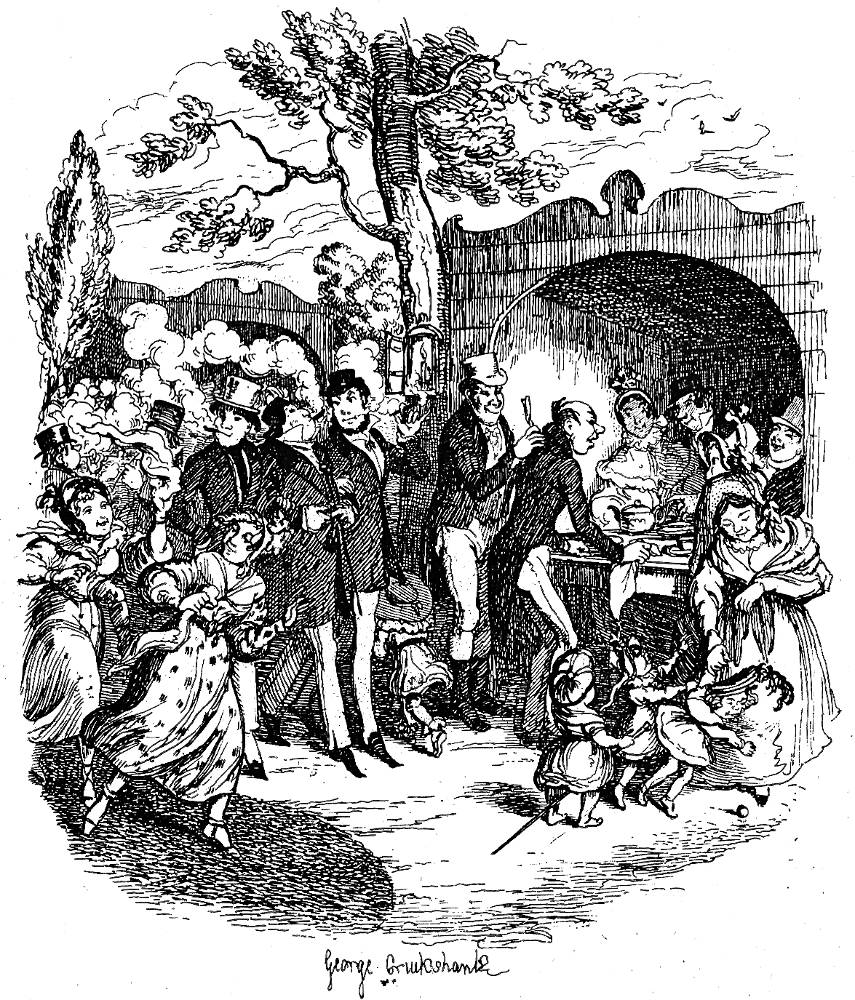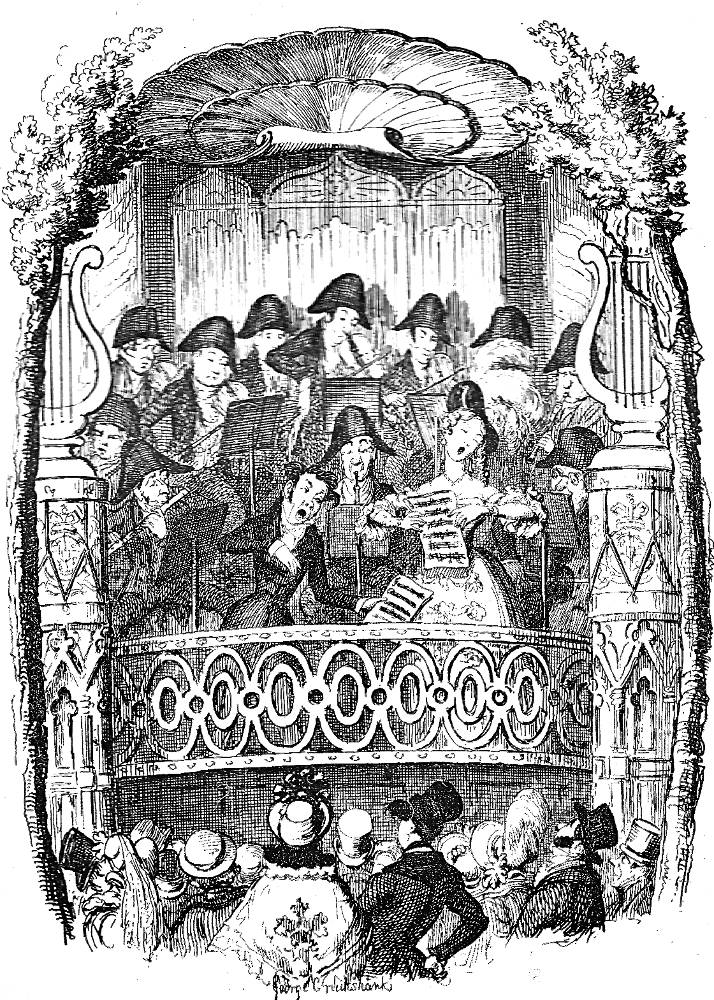
"What do you mean by that, scoundrel?" exclaimed Mr. Samuel Wilkins, grasping the gilt-knobbed dress cane. (wood-engraving). 1876. 9.3 cm high x 13.7 cm wide, framed. — Fred Barnard's exciting response to the rather staid tea-parlour illustrations of George Cruikshank. Whereas Cruikshank provided an introductory illustration which he re-drafted when the story was re-printed by Chapman and Hall in the "Characters" section of Sketches by Boz in 1839, Barnard chose a much more dramatic moment for visual realisation, involving Jemima, her beau, Samuel Wilkins, their friends, and the male rivals, "whiskers" and "plaid waistcoat."
Scanned image and text by Philip V. Allingham. [You may use this image without prior permission for any scholarly or educational purpose as long as you (1) credit the person who scanned the image and (2) link your document to this URL in a web document or cite the Victorian Web in a print one.]
Passage Illustrated
Comic song, accompanied on the organ. Miss J'mima Ivins was convulsed with laughter — so was the man with the whiskers. Everything the ladies did, the plaid waistcoat and whiskers did, by way of expressing unity of sentiment and congeniality of soul; and Miss J’mima Ivins, and Miss J'mima Ivins’s friend, grew lively and talkative, as Mr. Samuel Wilkins, and Miss J'mima Ivins's friend’s young man, grew morose and surly in inverse proportion.
Now, if the matter had ended here, the little party might soon have recovered their former equanimity; but Mr. Samuel Wilkins and his friend began to throw looks of defiance upon the waistcoat and whiskers. And the waistcoat and whiskers, by way of intimating the slight degree in which they were affected by the looks aforesaid, bestowed glances of increased admiration upon Miss J'mima Ivins and friend. The concert and vaudeville concluded, they promenaded the gardens. The waistcoat and whiskers did the same; and made divers remarks complimentary to the ankles of Miss J'mima Ivins and friend, in an audible tone. At length, not satisfied with these numerous atrocities, they actually came up and asked Miss J'mima Ivins, and Miss J'mima Ivins's friend, to dance, without taking no more notice of Mr. Samuel Wilkins, and Miss J'mima Ivins’s friend's young man, than if they was nobody!
"What do you mean by that, scoundrel!" exclaimed Mr. Samuel Wilkins, grasping the gilt-knobbed dress-cane firmly in his right hand. "What's the matter with you, you little humbug?" replied the whiskers. "How dare you insult me and my friend?" inquired the friend’s young man. "You and your friend be hanged!" responded the waistcoat. ‘Take that,’ exclaimed Mr. Samuel Wilkins. The ferrule of the gilt-knobbed dress-cane was visible for an instant, and then the light of the variegated lamps shone brightly upon it as it whirled into the air, cane and all. "Give it him," said the waistcoat. "Horficer!" screamed the ladies. Miss J'mima Ivins's beau, and the friend's young man, lay gasping on the gravel, and the waistcoat and whiskers were seen no more. — "Characters," Chapter 4, "Miss Evans and The Eagle," p. 110.
Commentary
The only precedent that Barnard had, George Cruikshank's Miss Jemima Evans (1836), was of little use to him since he much preferred dynanmic to static scenes. Now Chapter 4 in "Characters," the sketch does not develop character much beyond the surface, but finishes upon a point of conflict in a day typical of the life of the titular protagonist and of her class, denizens of Camden Town, a suburb several miles north of The City familiar to Dickens from youth and the area in which the Cratchits (reflexions of John and Elizabeth Dickens's family) live in A Christmas Carol. Since the sketch is very much a verbal portrait rather than a tale, one can appreciate George Cruikshank's impulse to describe the young couple as they appear at the outset — Samuel Wilkins, dressed for an evening out, and Jemima Evans in her white muslin dress that shows her shoulders to advantage. Barnard has not chosen to retain the details of the muslin dress worm by Jemima Evans in the original illustration, but has certainly retained the large straw bonnet. Having consumed alcoholic beverage at The Crown previously and now at The Eagle, Samuel Wilkins is prepared to attack a man much larger than he to defend his fiancée's honour, to say nothing of his own. The dangerous masher, "Whiskers," a formidable figure, and his less menacing companion ("plaid waistcoat") are central characters in the Household Edition wood-engraving for the anecdote, "What do you mean by that, scoundrel?" exclaimed Mr. Samuel Wilkins, grasping the gilt-knobbed dress cane, as Barnard realizes the climactic scene at The Eagle. Dominating the centre of the composition, the dark, menacing figure of "the whiskers" in black hat and tailcoat looms over a diminutive Wilkins in white trousers and white top-hat as Miss Evans grips his arm and takes alarm at the bully. Meantime, a secondary drama plays out in the right-hand register as Jemima's friend attempts to restrain her beau as he rolls up his sleeves to deal with the young man with the plaid waistcoat (right of centre). The background gives a fragmentary notion of The Eagle itself, with greenery and a fountain (right) and refreshment tables (upper left). Executing this drawing in 1876, Fred Barnard would have had to remember what The Eagle looked like before it became the Grecian Theatre in 1858, although evidently the rotunda was retained. Bentley et al. note that The Eagle at the junction of City Road and Shepherdess Walk, Hackney, was more than a mere public house, for it originated as a tea garden and then in 1825 was transformed into the music hall that serves as Dickens's backdrop:
Eagle, the (dem.), famous tavern and pleasure garden in the City Road, east London, a popular resort of the lower middle-class. The rotunda, where the concerta were held, was demolished in 1901 after being turned into the Grecian Theatre. Inside the gardens were 'beautifully gravelled and planted' walks with a 'place for dancing', 'variegated lamps', 'a Moorish band . . . and an opposition military band'. — The Dickens Index, p. 84.
The establishment is obliquely commemorated in the children's rhyme "Pop Goes the Weasel":
"Up and down the City Road In and out the Eagle." — "Notable Pubs #1: The Eagle Tavern, London."
An alternative meaning involves pawning one's coat in order to buy food and drink, as "weasel" is rhyming slang for "coat" and "pop" is a slang word for "pawn." — The Free Dictionary, cited in "Meaning and interpretations," "Pop Goes the Weasel," Wikipedia: https://en.wikipedia.org/wiki/Pop_Goes_the_Weasel
As Dickens's sketch on the subject (perhaps based direct experience of the place, although the tea-gardens at Jack Straw's Castle, Hampstead, were his favourite) makes plain, the 19th century British tea-garden (an institution which included the rejuvenated Eagle, with its grassy walks and fountains sketched in the backdrop of the present illustration) — perhaps one of the few entertainments available on a Sunday afternoon as a consequence of the restrictive Lord's Day Act — involved strolling around ponds and garden statues, and taking refreshment. Think of the tea-garden described by Dickens as the Vauxhall or Ranelagh Gardens for the rising middle-classes. In Chapter 46 of the Pickwick Papers (August 1837: Part 16), Dickens stages what turns out to be the arrest of the litigious Mrs. Bardell (for not paying her lawyers' fees) while on excursion with her friends in the pleasure gardens at The Spaniards in Hampstead. From 1840, shortly after Dickens wrote this sketch, music and dancing were licensed at several inns with tea gardens, such as The Bell in Kilburn High Road.
The character of these places have, with the habits of the people, experienced a very considerable change, and tea, formerly the chief article of consumption here, has been supplanted by liquors of a more stimulating character. At some of these, concerts, of an inferior description, are performed; and other attractions are added that generally detain the company, always of a miscellaneous character, till the approach of midnight. The following are the principal in the vicinity of the metropolis: — New Bagnigge Wells, Bayswater; New Bayswater Tea Gardens; Bull and Bush, Hampstead; Camberwell Grove House; Canonbury House, Islington; Chalk Farm, Primrose Hill; Copenhagen House, Holloway Fields; Eel-pie House, or Sluice House, on the New River, near Hornsey: St. Helena Gardens, near the Lower Road, Deptford; Highbury Barn; Hornsey Wood House, the grounds of which include a fine wood and an extensive piece of water; Jack Straw's Castle, Hampstead Heath; Kilburn Wells, Edgeware Road; Mermaid, Hackney; Montpelier, Walworth; Mount Pleasant, Clapton; the Eagle, City Road; the Red House, Battersea Fields; Southampton Arms, Camden Town; Union Gardens, Chelsea; White Conduit House, Islington; and Yorkshire Stingo, Lisson Green. — Mogg's New Picture of London and Visitor's Guide to it Sights, 1844; cited in Jackson.
See also "The Development of Leisure in Britain, 1700-1850:
- The Development of Leisure in Britain, 1700-1850
- The Development of Leisure in Britain after 1850
- Technology and Leisure in Britain after 1850
Relevant Illustrations from the same edition



Left: Cruikshank's far more animated and engaging bacchanal, Greenwich Fair. Centre: Cruikshank's view of a lively pleasure garden for the middle class, London Recreations. Right: Cruikshank's view of a more cultured recreational experience, Vauxhall Gardens by Day. [Click on the images to enlarge them.]
Bibliography
"18th & 19th Century Pleasure and Tea Gardens in London." Jane Austen's World. Posted March 1, 2009 by Vic. Accessed 27 April 2017. in Jane Austen's World. https://janeaustensworld.wordpress.com/2009/03/01/18th-amp-19th-century-pleasure-and-tea-gardens-in-london/.
Ackroyd, Peter. Dickens: A Biography. London: Sinclair-Stevenson, 1990.
Bentley, Nicholas, Michael Slater, and Nina Burgis. The Dickens: Index. Oxford: Oxford U. P., 1990.
Cohen, Jane Rabb. Part One, "Dickens and His Early Illustrators: 1. George Cruikshank. Charles Dickens and His Original Illustrators. Columbus: Ohio University Press, 1980. Pp. 15-38.
Davis, Paul. Charles Dickens A to Z. The Essential Reference to His Life and Work. New York: Checkmark and Facts On File, 1998.
Dickens, Charles. The Adventures of Oliver Twist. Illustrated by George Cruikshank. London: Chapman and Hall, 1846.
Dickens, Charles. "London Recreations," Chapter 9 in "Scenes," Sketches by Boz. Illustrated by George Cruikshank. London: Chapman and Hall, 1839; rpt., 1890. Pp. 67-71.
Dickens, Charles. "London Recreations," Chapter 9 in "Scenes," Sketches by Boz. Illustrated by Fred Barnard. The Household Edition. London: Chapman and Hall, 1876. Pp. 43-45.
Dickens, Charles. "London Recreations," Chapter 9 in "Scenes," Sketches by Boz. Illustrated by Harry Furniss. The Charles Dickens Library Edition. London: Educational Book Company, 1910. Vol. 1. Pp. 86-91.
Dickens, Charles. "Miss Evans and The Eagle," Chapter 4 in "Characters," Sketches by Boz. Illustrated by George Cruikshank. London: Chapman and Hall, 1839; rpt., 1890. Pp. 170-174.
Dickens, Charles. "Miss Evans and The Eagle," "Characters," Chapter 4, Christmas Books and Sketches by Boz, Illustrative of Every-day Life and Every-day People. Illustrated by Sol Eytinge, Jr. The Diamond Edition. Boston: James R. Osgood, 1875 [rpt. of 1867 Ticknor & Fields edition]. Pp.353-355.
Dickens, Charles. "Miss Evans and The Eagle," Chapter 4 in "Characters," Sketches by Boz. Illustrated by Fred Barnard. The Household Edition. London: Chapman and Hall, 1876. Pp. 108-110.
Dickens, Charles. "Miss Evans and The Eagle," Chapter 4 in "Characters," Sketches by Boz. Illustrated by Harry Furniss. The Charles Dickens Library Edition. London: Educational Book Company, 1910. Vol. 1. Pp. 219-223.
Hawksley, Lucinda Dickens. Chapter 3, "Sketches by Boz." Dickens Bicentenary 1812-2012: Charles Dickens. San Rafael, California: Insight, 2011. Pp. 12-15.
Jackson, Lee. "Victorian London - Entertainment and Recreation - Gardens - Tea Gardens."Dirty Old London. New Haven: Yale UP, 2014. Accessed 27 April 2017. http://www.victorianlondon.org/entertainment/teagardens.htm
"Meaning and interpretations," "Pop Goes the Weasel," Wikipedia. Accessed 17 May 2017. https://en.wikipedia.org/wiki/Pop_Goes_the_Weasel
"Notable Pubs #1: The Eagle Tavern, London" Boak and Bailey's Beer Blog. Accessed 17 May 2017. http://boakandbailey.com/2015/05/notable-pubs-1-the-eagle-tavern-london/
Schlicke, Paul. "Sketches by Boz." Oxford Reader's Companion to Dickens. Oxford: Oxford U. P., 1999. Pp. 530-535.
Slater, Michael. Charles Dickens: A Life Defined by Writing. New Haven and London: Yale U. P., 2009.
Last modified 17 May 2017